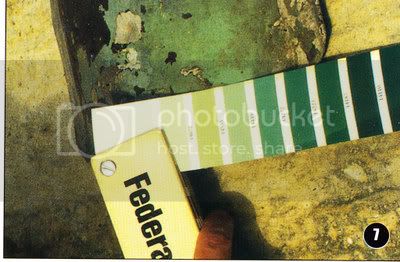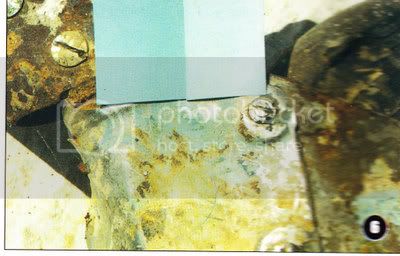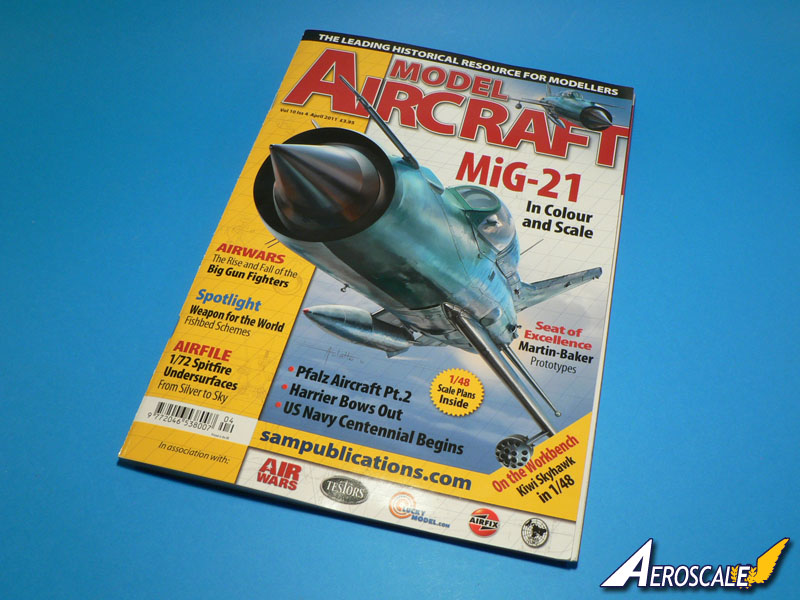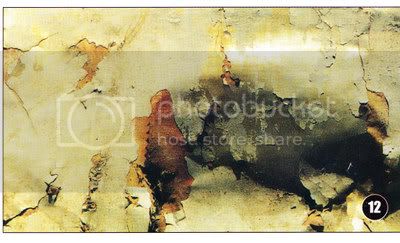The under surface colours featured in the article are based on archaeological evidence gathered in the 1990s and published around the turn of this centaury.
It can be deduced from the repeated references to Sky Type S being used, when supplies become available, which appear in documents throughout June and July of 1940, that supplies of Sky to either DTD 63A reduced gloss, or DTD 83A, DTD 308 and DTD 314 Type S, were generally not available to fighter squadrons during those months.
Eyewitness accounts of the period June/August 1940, suggest that there were various shades of green, blue and grey being used of day Fighter under surfaces before Sky became the most commonly seen colour from late-August onwards.
Archaeological evidence suggests that what would appear to have happened is that, following Signal X915 of 6th June 1940, the fighter squadrons began to indent the stores organisation for supplies of Sky Type S. However as supplies of this colour and material were difficult, if not impossible to obtain they were forced to use something else instead. It might be reasonable to assume that when confronted with demands for a colour and material which was not available, the paint manufacturers would supply whatever was available.
British Standard Specification 381 ‘Schedule of Colours for Ready Mixed Paints’ was issued in November 1930 and still current in 1940 and available to DTD 63A. The standard appears to offer two colours which might possibly have been used, which would account for the subjective colloquial descriptions of the under surface colours reported by eyewitnesses at the time of ‘duck egg blue’, and ‘a rich duck egg green’. These colours were BSS 381 (1930) No 1 Sky Blue, a light blue-green colour which could be described as duck egg blue; and No 16 Eau de Nil which could be considered to be a duck egg green. That these two colours were used in place of Sky is supported by the available archaeological evidence, wreckage of aircraft lost during 1940 held in a number of museums in Kent and Sussex.
Matching the samples of paint still adhering to wreckage of several aircraft revealed that the ‘rich duck egg green’ had several minor variations in colour while all were consistently smooth and slightly glossy, while only one shade of blue which was also smooth and slightly glossy , appears to have been used. Comparison with various colour standards revealed that all the minor variations in the ‘rich duck egg green’ were near matches for BSS 381 (1930) No 16 Eau de Nil; while the ‘duck egg blue’ was a match for BSS 381 (1930) No 1 Sky Blue. When the dates the aircraft were lost is set down in chronological order a pattern suggests itself.
Aircraft Date Lost Under Surface Colour
Hurricane, P3479, 56Sqn 13 August Sky
Hurricane, V6581, 85 Sqn 31 August BSS 381 (1930) No1 Sky Blue
Hurricane, P2946, 253 Sqn 2 September Sky
Hurricane, P3310, 73 Sqn 5 September ‘Eau de Nil’
Hurricane R4230, 249 Sqn 7 September ‘Eau de Nil’
Spitfire, P9467, 603 Sqn 7 September Sky Grey
Hurricane, P2728, 607 Sqn 7 September ‘Blue Grey’
Spitfire, X4325, 41Sqn 11 September Sky Grey
Spitfire, R6625 14 September Sky
Hurricane, V7357 17 September Sky
Spitfire, X4410 20 September Sky
Spitfire, X4422, 92 Sqn 27 September Sky
Spitfire, P9469, 222 Sqn 7 October ‘Eau de Nil and BSS 381 (1930)
No.1 Sky Blue
Hurricane, V6722, 501 Sqn 8 October Sky
Hurricane, L1928, 253 Sqn 10 October Sky
Spitfire, P7303, 616 Sqn 27 October Sky
Hurricane, V6879, 605 Sqn 1 November Sky
Blenheim, T2161, 82 Sqn 4 December ‘Eau de Nil’
Sky only becomes common from mid-September onwards with substitute colours by far the most common until then. While such a small sample cannot be regarded as conclusive, it does appear to reflect the picture obtained from the documents consulted and eyewitness accounts.
The paints used instead of Sky therefore appear to be of three colours. The first is Sky Grey which was surprisingly common given that there is little if any mention of it being used on RAF aircraft at this time in published literature. Besides the aircraft known to have carried Sky Grey listed above it has also found on the remains of two separate but unidentifiable aircrafts’ remains.
The second colour has been described as ‘Eau de Nil’ in the above list’. Examination of the wreckage revealed that there were several slightly different shades of the Eau de Nil colour. These range for an exact match for BSS 381 (1930) No 16 Eau de Nil, to FS 595B 14533 and 14449. These are not widely differing colours; the difference is so slight that samples of each colour have to be compared next to each other in order to perceive a difference. This slight difference may be due to supplies of paint being obtained from different manufacturers, or being from different batches of paint from the same manufacturer. In all cases the surface finish was smooth and quite glossy indicative of materials supplied to DTD 63A with reduced gloss.
One specific example where Eau de Nil has been used where Sky was called for was Spitfire P9469 of 222 Squadron coded ZD*T that was lost on 7th October 1940, the remains held by the Robertsbridge Aviation Society.
While there is not trace of the Night and White scheme on the wreckage, it was found to have three layers of paint. The first layer of paint next to the metal appeared on the surface to be an unidentified brown colour. However, when a loose flake of the paint was removed by one of the Society’s members, the side that had been next to metal was found to be an exact match for BSS 381 (1930) No 16 Eau de Nil.
The second layer of paint was a green colour matched to FS 14449. It had a very smooth finish, which while not a full gloss, had some degree of shine. This might be indicative of DTD 63A with reduced gloss.
The top layer of paint matched BSS 381 (1930) No 1 Sky Blue. This is a pale blue with a hint of green which could colloquially be described as ‘duck egg blue’. This was also found to be smooth and shiny indicative of DTD 63A with reduced gloss.
Thus it would appear that P9469 was repainted in service hands at least three times during the summer of 1940 without actually having carrying the right colour.
Hurricane, P2728 was painted with a blue-grey colour that has not been matched any of the known standards. The closest FB 595 match is 35414 but is too dark and too green.
If the RAF could not get supplies of Sky Type S, it would seem the aircraft manufacturers were little better off. While eyewitness accounts suggest that Blenheims built by Bristol in the early part of 1940 were finished Sky, albeit to DTD 63A with reduced gloss, archaeological evidence shows that the colour that was applied to Blenheim under surfaces on the production line at Rootes was not.
The evidence is provided by the remains of Blenheim Mk IV, T2161 of 82 Squadron held by Brenzett Aviation Museum. This particular was built by Rootes and first delivered to the RAF on 10th August 1940, at a time when according to the accepted view; Sky was well established both on the production line and in service. The paint that remains on the wreckage is however, quite unlike the correct shade of Sky, being an excellent match for FS 595B 14533. This is a near match for BSS 381 (1930) Eau de Nil. Once again the finish is very smooth and glossy indicative of materials to DTD 63A with reduced gloss.
In some cases, individual units mixed their own paint but so far no official documentation has been found on this subject. The Service was advised not to mix materials to DTD 308 with those of DTD 314 to this end. Some idea of the confusion caused by the introduction of Sky Type S is found in the correspondence of Wg Cdr WEB Hurst, then a 22-year-old corporal. He wrote to his wife from his posting in Gloucestershire in August 1940:
"We had to paint some of our kites and for some obscure reason we had to paint them duck egg blue. Why they should choose duck egg blue I can't imagine but ours is not to reason why, so duck egg blue they had to be.
Well, to start with we couldn't get any duck egg blue paint, nobody seemed to have heard of it, so the only thing to do was to mix some. The first thing we had to decide was 'what colour is duck egg blue?'
Nobody knew. Nobody could even remember having seen a duck's egg in the raw, so we were stumped again. Funnily enough nobody but me thought of trying to get hold of a duck's egg from somewhere but somehow my suggestion, that someone should be sent to try and procure one, wasn't received very favourably.
Then we found somebody who remembered having to mix some before. Oh it was a long time ago but he definitely remembered having to mix blue and white paint to the ratio 15:6. Oh good. But was it 15 parts of blue or 15 parts of white? He wasn't sure but thought it was blue. The only thing to do was to try it out and see what it looked like. Well, I should like to see the duck that could lay a beautiful Oxford blue egg! We concluded it must be the other way about, so we mixed a lot more white with it and eventually got about five gallons of a sort of Cambridge blue, which we all agreed a duck's egg might possibly look like! We slapped this on and as it didn't look too bad we left it to dry and went to dinner. When we got back something seemed to have gone wrong for our duck egg blue had dried a beautiful violet! Now this was rather disheartening but it was quite funny to see the Flight Sergeant tearing his hair when he saw it, so we asked him to have a go. He suggested putting more white and some yellow with our mixture. We followed his suggestion and the resulting mixture didn't look too bad, though a bit greenish, but a duck might possibly have been able to produce an egg to match it, so we slapped that over the top of the violet. I don't think it will look too bad when dry but we shan't know the final result until we see it tomorrow. I don't think anyone will dare to open the hangar door in the morning."
In a letter two days later, he said:
"We finished duck egg blueing our planes by the way. That first one dried alright and as we had used all the paint on it we had to mix some more and get the right shade. Most of them are a bluey greeney shade, but some of them vary from an almost pea green to almost sky blue!"
BSS 381 (1930) No 1 Sky Blue. Known colloquially as duck egg blue which is a good description of its aquamarine hue. The closest FS 595B match is 14325. The current No 101 Sky Blue is a little darker than the No1 Sky Blue in the 1930 edition. (The numbering system was altered in the 1948 edition.) Available from White Ensign Miniatures (WEM) in their Color Coats range.
BSS 381 (1930) No 16 Eau de Nil). Known colloquially as duck egg green. Its grey/green hue may be described as a rich duck egg green. The closest FS 595B match is 14533. Available from White Ensign Miniatures (WEM) in their Color Coats range.

Colour matching on P9469. The colour is described as a rich duck egg green and was an excellent match for FS 595B 14449.

Colour matching on the tailwheel strut of P9469. In this instance the colour was a duck egg blue that matched BSS 381 No1 Sky Blue.

P9469. Here both the duck egg green and duck egg blue colours and be seen. Both finishes were smooth and quite glossy. The green had been applied first and later overpainted with the blue.






















